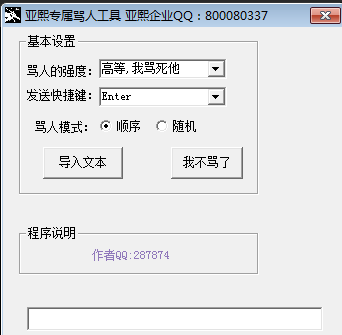Berkeley DB Java Edition 简介
时间:2022-03-13 22:55
JE的记录包含两部分,key键值和value数据值,这两个值都是通过DatabaseEntry对象封装起来,所以说如果要使用记录,则你必须创建两个DatabaseEntry对象,一个是用来做为key,另外一个是做为value.
DatabaseEntry能够支持任何的能够转换为bytes数组形式的基本数据。包括所有的JAVA基本类型和可序列化的对象.
使用记录
示例一:把字符串转换DatabaseEntry
示例二:把DatabaseEntry里的数据转换成字符串
读和写database 记录
读和写database记录的时候大体是基本一样的,唯一有区别的是每个key写是否允许写多条记录,默认情况下是不支持多条记录的。
a) 你可以使用如下方法向database 里添加记录
l Database.put()
向database中添加一条记录。如果你的database不支持一个key对应多个data或当前database中已经存在该key了,则使用此方法将使用新的值覆盖旧的值。
l Database.putNoOverwrite()
向database中添加新值但如果原先已经有了该key,则不覆盖。不管database是否允许支持多重记录(一个key对应多个value),只要存在该key就不允许添加,并且返回perationStatus.KEYEXIST信息。
l Database.putNoDupData()
想database中添加一条记录,如果database中已经存在了相同的 key和value则返回 OperationStatus.KEYEXIST.
使用示例:
b) 你可以使用如下方法从database 里读取记录
1. Database.get()
基本的读记录的方法,通过key的方式来匹配,如果没有改记录则返回OperationStatus.NOTFOUND。
l Database.getSearchBoth()
通过key和value来同时匹配,同样如果没有记录匹配key和value则会返回OperationStatus.NOTFOUND。
使用示例:
c) 删除记录
可以使用Database.delete()这个方法来删除记录。如果你的database支持多重记录,则当前key下的所有记录都会被删除,如果只想删除多重记录中的一条则可以使用游标来删除。
当然你也可以使用Environment.truncateDatabase()这个方法来清空database 中的所有记录。
使用示例:
package je.gettingStarted;
import com.sleepycat.je.Database;
import com.sleepycat.je.DatabaseEntry;
...
try {
String aKey = "myFirstKey";
DatabaseEntry theKey = new DatabaseEntry(aKey.getBytes("UTF-8"));
myDatabase.delete(null, theKey);
} catch (Exception e) {
}
d) 提交事务
当你对database进行了写操作的时候,你的修改不一定马上就能生效,有的时候他仅仅是缓存在RAM中,如果想让你的修改立即生效,则可以使用Environment.sync()方法来把数据同步到磁盘中去。
e) 不同类型的数据的处理
1. 你可以使用DatabaseEntry来绑定基本的JAVA数据类型,主要有String、Character、Boolean、Byte、Short、Integer、Long、Float、Double.
使用示例一:
package je.gettingStarted;
import com.sleepycat.bind.EntryBinding;
import com.sleepycat.bind.tuple.TupleBinding;
import com.sleepycat.je.DatabaseEntry;
...
try {
String aKey = "myLong";
DatabaseEntry theKey = new
DatabaseEntry(aKey.getBytes("UTF-8"));
Long myLong = new Long(123456789l);
DatabaseEntry theData = new DatabaseEntry();
EntryBinding myBinding =
TupleBinding.getPrimitiveBinding(Long.class);
myBinding.objectToEntry(myLong, theData);
myDatabase.put(null, theKey, theData);
} catch (Exception e) {
// Exception handling goes here
}
使用示例二:
package je.gettingStarted;
import com.sleepycat.bind.EntryBinding;
import com.sleepycat.bind.tuple.TupleBinding;
import com.sleepycat.je.Database;
import com.sleepycat.je.DatabaseEntry;
import com.sleepycat.je.LockMode;
import com.sleepycat.je.OperationStatus;
...
Database myDatabase = null;
try {
String aKey = "myLong";
DatabaseEntry theKey = new
DatabaseEntry(aKey.getBytes("UTF-8"));
DatabaseEntry theData = new DatabaseEntry();
EntryBinding myBinding =
TupleBinding.getPrimitiveBinding(Long.class);
OperationStatus retVal = myDatabase.get(null, theKey, theData,
LockMode.DEFAULT);
String retKey = null;
if (retVal == OperationStatus.SUCCESS) {
Long theLong = (Long) myBinding.entryToObject(theData);
retKey = new String(theKey.getData(), "UTF-8");
System.out.println("For key: ‘" + retKey + "‘ found Long: ‘" +
theLong + "‘.");
} else {
System.out.println("No record found for key ‘" + retKey + "‘.");
}
} catch (Exception e) {
// Exception handling goes here
}
2. 可序列化的对象的绑定
1. 首先你需要创建一个可序列化对象
2. 打开或创建你的database,你需要两个,一个用来存储你的数据,另外一个用来存储类信息。
3. 实例化catalog类,这个时候你可以使用com.sleepycat.bind.serial.StoredClassCatalog,来存储你的类信息。
4. 通过com.sleepycat.bind.serial.SerialBinding来绑定数据和类。
5. 绑定并存储数据。
示例:
l 创建一个可序列化的对象
package je.gettingStarted;
import java.io.Serializable;
public class MyData implements Serializable {
private long longData;
private double doubleData;
private String description;
MyData() {
longData = 0;
doubleData = 0.0;
description = null;
}
public void setLong(long data) {
longData = data;
}
public void setDouble(double data) {
doubleData = data;
}
public void setDescription(String data) {
description = data;
}
public long getLong() {
return longData;
}
public double getDouble() {
return doubleData;
}
public String getDescription() {
return description;
}
}
l 存储数据
package je.gettingStarted;
import com.sleepycat.bind.EntryBinding;
import com.sleepycat.bind.serial.StoredClassCatalog;
import com.sleepycat.bind.serial.SerialBinding;
import com.sleepycat.je.Database;
import com.sleepycat.je.DatabaseConfig;
import com.sleepycat.je.DatabaseEntry;
...
String aKey = "myData";
MyData data2Store = new MyData();
data2Store.setLong(123456789l);
data2Store.setDouble(1234.9876543);
data2Store.setDescription("A test instance of this class");
try {
DatabaseConfig myDbConfig = new DatabaseConfig();
myDbConfig.setAllowCreate(true);
myDbConfig.setSortedDuplicates(true);
Database myDatabase = myDbEnv.openDatabase(null, "myDb", myDbConfig);
myDbConfig.setSortedDuplicates(false);
//打开用来存储类信息的库
Database myClassDb = myDbEnv.openDatabase(null, "classDb", myDbConfig);
// 3)创建catalog
StoredClassCatalog classCatalog = new StoredClassCatalog(myClassDb);
// 4)绑定数据和类
EntryBinding dataBinding = new SerialBinding(classCatalog,
MyData.class);
DatabaseEntry theKey = new DatabaseEntry(aKey.getBytes("UTF-8"));
// 向DatabaseEntry里写数据
DatabaseEntry theData = new DatabaseEntry();
dataBinding.objectToEntry(data2Store, theData);
myDatabase.put(null, theKey, theData);
} catch (Exception e) {
// 错误处理
}
l 读数据
package je.gettingStarted;
import com.sleepycat.bind.EntryBinding;
import com.sleepycat.bind.serial.StoredClassCatalog;
import com.sleepycat.bind.serial.SerialBinding;
import com.sleepycat.je.Database;
import com.sleepycat.je.DatabaseConfig;
import com.sleepycat.je.DatabaseEntry;
import com.sleepycat.je.LockMode;
...
// The key data.
String aKey = "myData";
try {
DatabaseConfig myDbConfig = new DatabaseConfig();
myDbConfig.setAllowCreate(false);
Database myDatabase = myDbEnv.openDatabase(null, "myDb", myDbConfig);
//用来存储类信息的库
Database myClassDb = myDbEnv.openDatabase(null, "classDb", myDbConfig);
// 实例化catalog
StoredClassCatalog classCatalog = new StoredClassCatalog(myClassDb);
// 创建绑定对象
EntryBinding dataBinding = new SerialBinding(classCatalog,
MyData.class);
DatabaseEntry theKey = new DatabaseEntry(aKey.getBytes("UTF-8"));
DatabaseEntry theData = new DatabaseEntry();
myDatabase.get(null, theKey, theData, LockMode.DEFAULT);
// Recreate the MyData object from the retrieved DatabaseEntry using
// 根据存储的类信息还原数据
MyData retrievedData=(MyData)dataBinding.entryToObject(theData);
} catch (Exception e) {
// Exception handling goes here
}
3. 自定义对象的绑定
使用tuple binding 来绑定自定义数据的步骤
①. 实例化你要存储的对象
②. 通过com.sleepycat.bind.tuple.TupleBinding class来创建一个tuple binding。
③. 创建一个database,跟序列化的对象不同,你只需要创建一个。
④. 通过继承第二步的类来创建一个entry binding 对象。
⑤. 存储和使用数据
使用示例:
l 创建要存储的对象
package je.gettingStarted;
public class MyData2 {
private long longData;
private Double doubleData;
private String description;
public MyData2() {
longData = 0;
doubleData = new Double(0.0);
description = "";
}
public void setLong(long data) {
longData = data;
}
public void setDouble(Double data) {
doubleData = data;
}
public void setString(String data) {
description = data;
}
public long getLong() {
return longData;
}
public Double getDouble() {
return doubleData;
}
public String getString() {
return description;
}
}
l 创建一个TupleBinding对象
package je.gettingStarted;
import com.sleepycat.bind.tuple.TupleBinding;
import com.sleepycat.bind.tuple.TupleInput;
import com.sleepycat.bind.tuple.TupleOutput;
public class MyTupleBinding extends TupleBinding {
// 把对象转换成TupleOutput
public void objectToEntry(Object object, TupleOutput to) {
MyData2 myData = (MyData2)object;
to.writeDouble(myData.getDouble().doubleValue());
to.writeLong(myData.getLong());
to.writeString(myData.getString());
}
//把TupleInput转换为对象
public Object entryToObject(TupleInput ti) {
Double theDouble = new Double(ti.readDouble());
long theLong = ti.readLong();
String theString = ti.readString();
MyData2 myData = new MyData2();
myData.setDouble(theDouble);
myData.setLong(theLong);
myData.setString(theString);
return myData;
}
}
l 读和写数据
package je.gettingStarted;
import com.sleepycat.bind.tuple.TupleBinding;
import com.sleepycat.je.DatabaseEntry;
...
TupleBinding keyBinding = new MyTupleBinding();
MyData2 theKeyData = new MyData2();
theKeyData.setLong(123456789l);
theKeyData.setDouble(new Double(12345.6789));
theKeyData.setString("My key data");
DatabaseEntry myDate = new DatabaseEntry();
try {
// 把theKeyData 存储到DatabaseEntry里
keyBinding.objectToEntry(theKeyData, myDate);
...
// Database 进行了一些读和写操作
...
// Retrieve the key data
theKeyData = (MyData2) keyBinding.entryToObject(myDate);
} catch (Exception e) {
// 错误处理
}
f) 使用比较器
JE是使用BTrees来组织结构的,这意味着当对database的读和写需要涉及BTrees间的节点比较。这些比较在key间是经常的发生的。如果你的database支持多重记录,那么也会存在data间的比较。
默认的情况JE的比较器是按照字节的方式来进行比较的,这通常情况下能处理大多数的情况。但有的时候确实需要自定义比较器用于特殊的通途,比如说按照key来排序。
l 创建自己的比较器
其实很简单,只要你重写Comparator class中的比较方法(compare)就可以了,通过Comparator.compare()会传递给你两个byte 数组形式的值,如果你知道结构,则可以根据你自己定义的方法来进行比较
示例:
package je.gettingStarted;
import java.util.Comparator;
public class MyDataComparator implements Comparator {
public MyDataComparator() {}
public int compare(Object d1, Object d2) {
byte[] b1 = (byte[])d1;
byte[] b2 = (byte[])d2;
String s1 = new String(b1, "UTF-8");
String s2 = new String(b2, "UTF-8");
return s1.compareTo(s2);
}
}
l 让database使用你自定义的比较器
如果你想改变database中基本的排序方式,你只能重新创建database并重新导入数据。
①. DatabaseConfig.setBtreeComparator()
用于在database里两个key的比较
②. DatabaseConfig.setOverrideBtreeComparator()
如果为true则代表让database使用 DatabaseConfig.setBtreeComparator()设置的比较器来代替默认的比较器。
③. DatabaseConfig.setDuplicateComparator()
用于database可以使用多重记录的时候的data的 比较。
④. DatabaseConfig.setOverrideDuplicateComparator()
如果为true则代表让database使用 DatabaseConfig. setDuplicateComparator()设置 的比 较器来代替默认的比较器。
使用示例:
package je.gettingStarted;
import com.sleepycat.je.Database;
import com.sleepycat.je.DatabaseConfig;
import com.sleepycat.je.DatabaseException;
import java.util.Comparator;
...
try {
DatabaseConfig myDbConfig = new DatabaseConfig();
myDbConfig.setAllowCreate(true);
// 设置要使用的比较器
myDbConfig.setDuplicateComparator(MyDataComparator.class);
// 使用自己定义的比较器
myDbConfig.setSortedDuplicates(true);
Database myDatabase = myDbEnv.openDatabase(null, "myDb", myDbConfig);
} catch (DatabaseException dbe) {
// Exception handling goes here
}
package je.gettingStarted;
import com.sleepycat.je.Cursor;
import com.sleepycat.je.CursorConfig;
import com.sleepycat.je.Database;
import com.sleepycat.je.DatabaseException;
import com.sleepycat.je.Environment;
import java.io.File;
...
Environment myDbEnvironment = null;
Database myDatabase = null;
Cursor myCursor = null;
try {
myDbEnvironment = new Environment(new File("/export/dbEnv"), null);
myDatabase = myDbEnvironment.openDatabase(null, "myDB", null);
myCursor = myDatabase.openCursor(null, null);
} catch (DatabaseException dbe) {
// Exception handling goes here ...
}
package je.gettingStarted;
import com.sleepycat.je.Cursor;
import com.sleepycat.je.Database;
import com.sleepycat.je.Environment;
...
try {
...
} catch ... {
} finally {
try {
if (myCursor != null) {
myCursor.close();
}
if (myDatabase != null) {
myDatabase.close();
}
if (myDbEnvironment != null) {
myDbEnvironment.close();
}
} catch(DatabaseException dbe) {
System.err.println("Error in close: " + dbe.toString());
}
}
package je.gettingStarted;
import com.sleepycat.je.Cursor;
import com.sleepycat.je.Database;
import com.sleepycat.je.DatabaseEntry;
import com.sleepycat.je.DatabaseException;
import com.sleepycat.je.LockMode;
import com.sleepycat.je.OperationStatus;
...
Cursor cursor = null;
try {
cursor = myDatabase.openCursor(null, null);
DatabaseEntry foundKey = new DatabaseEntry();
DatabaseEntry foundData = new DatabaseEntry();
// 通过cursor.getNex方法来遍历记录
while (cursor.getNext(foundKey, foundData, LockMode.DEFAULT) ==
OperationStatus.SUCCESS) {
String keyString = new String(foundKey.getData(), "UTF-8");
String dataString = new String(foundData.getData(), "UTF-8");
System.out.println("Key | Data : " + keyString + " | " +
dataString + "");
}
} catch (DatabaseException de) {
System.err.println("Error accessing database." + de);
} finally {
// 使用后必须关闭游标
cursor.close();
}
package je.gettingStarted;
import com.sleepycat.je.Cursor;
import com.sleepycat.je.Database;
import com.sleepycat.je.DatabaseEntry;
import com.sleepycat.je.DatabaseException;
import com.sleepycat.je.LockMode;
import com.sleepycat.je.OperationStatus;
...
Cursor cursor = null;
try {
...
// Open the cursor.
cursor = myDatabase.openCursor(null, null);
DatabaseEntry foundKey = new DatabaseEntry();
DatabaseEntry foundData = new DatabaseEntry();
// 使用cursor.getPrev方法来遍历游标获取数据
while (cursor.getPrev(foundKey, foundData, LockMode.DEFAULT)
== OperationStatus.SUCCESS) {
String theKey = new String(foundKey.getData(), "UTF-8");
String theData = new String(foundData.getData(), "UTF-8");
System.out.println("Key | Data : " + theKey + " | " + theData + "");
}
} catch (DatabaseException de) {
System.err.println("Error accessing database." + de);
} finally {
// 使用后必须关闭游标
cursor.close();
}
查询的key
查询的data
游标指向
Alaska
Fa
Alaska/Fairbanks
Arizona
Fl
Arizona/Florence
Alaska
An
Alaska/Anchorage
package je.gettingStarted;
import com.sleepycat.je.Cursor;
import com.sleepycat.je.Database;
import com.sleepycat.je.DatabaseEntry;
import com.sleepycat.je.DatabaseException;
import com.sleepycat.je.LockMode;
import com.sleepycat.je.OperationStatus;
...
String searchKey = "Alaska";
String searchData = "Fa";
Cursor cursor = null;
try {
...
cursor = myDatabase.openCursor(null, null);
DatabaseEntry theKey =
new DatabaseEntry(searchKey.getBytes("UTF-8"));
DatabaseEntry theData =
new DatabaseEntry(searchData.getBytes("UTF-8"));
cursor = myDatabase.openCursor(null, null);
OperationStatus retVal = cursor.getSearchBothRange(theKey,
theData, LockMode.DEFAULT);
if (retVal == OperationStatus.NOTFOUND) {
System.out.println(searchKey + "/" + searchData +
" not matched in database " +
myDatabase.getDatabaseName());
} else {
String foundKey = new String(theKey.getData(), "UTF-8");
String foundData = new String(theData.getData(), "UTF-8");
System.out.println("Found record " + foundKey + "/" + foundData +
"for search key/data: " + searchKey +
"/" + searchData);
}
} catch (Exception e) {
// Exception handling goes here
} finally {
cursor.close();
}
package je.gettingStarted;
import com.sleepycat.je.Cursor;
import com.sleepycat.je.Database;
import com.sleepycat.je.DatabaseEntry;
import com.sleepycat.je.DatabaseException;
import com.sleepycat.je.LockMode;
import com.sleepycat.je.OperationStatus;
...
Cursor cursor = null;
try {
...
// Create DatabaseEntry objects
// searchKey is some String.
DatabaseEntry theKey = new DatabaseEntry(searchKey.getBytes("UTF-8"));
DatabaseEntry theData = new DatabaseEntry();
cursor = myDatabase.openCursor(null, null);
OperationStatus retVal = cursor.getSearchKey(theKey,
theData, LockMode.DEFAULT);
// 如果count超过一个,则遍历
if (cursor.count() > 1) {
while (retVal == OperationStatus.SUCCESS) {
String keyString = new String(theKey.getData(), "UTF-8");
String dataString = new String(theData.getData(), "UTF-8");
System.out.println("Key | Data : " + keyString + " | " +
dataString + "");
retVal = cursor.getNextDup(theKey, theData, LockMode.DEFAULT);
}
}
} catch (Exception e) {
// Exception handling goes here
} finally {
// Make sure to close the cursor
cursor.close();
}
如果存在相同的key在database里则返OperationStatus.KEYEXIS,
如果不存在key则添加数据。
package je.gettingStarted;
import com.sleepycat.je.Cursor;
import com.sleepycat.je.Database;
import com.sleepycat.je.DatabaseEntry;
import com.sleepycat.je.OperationStatus;
...
String key1str = "My first string";
String data1str = "My first data";
String key2str = "My second string";
String data2str = "My second data";
String data3str = "My third data";
Cursor cursor = null;
try {
...
DatabaseEntry key1 = new DatabaseEntry(key1str.getBytes("UTF-8"));
DatabaseEntry data1 = new DatabaseEntry(data1str.getBytes("UTF-8"));
DatabaseEntry key2 = new DatabaseEntry(key2str.getBytes("UTF-8"));
DatabaseEntry data2 = new DatabaseEntry(data2str.getBytes("UTF-8"));
DatabaseEntry data3 = new DatabaseEntry(data3str.getBytes("UTF-8"));
cursor = myDatabase.openCursor(null, null);
OperationStatus retVal = cursor.put(key1, data1); // 添加成功
retVal = cursor.put(key2, data2); // 添加成功
retVal = cursor.put(key2, data3); // 如果允许多重记录则添加成功 //否则添加失败
} catch (Exception e) {
// Exception handling goes here
} finally {
// Make sure to close the cursor
cursor.close();
}
package je.gettingStarted;
import com.sleepycat.je.Cursor;
import com.sleepycat.je.Database;
import com.sleepycat.je.DatabaseEntry;
import com.sleepycat.je.LockMode;
import com.sleepycat.je.OperationStatus;
...
Cursor cursor = null;
try {
...
DatabaseEntry theKey = new DatabaseEntry(searchKey.getBytes("UTF-8"));
DatabaseEntry theData = new DatabaseEntry();
cursor = myDatabase.openCursor(null, null);
OperationStatus retVal = cursor.getSearchKey(theKey, theData, LockMode.DEFAULT);
//如果date不是多重记录.
if (cursor.count() == 1) {
System.out.println("Deleting " +
new String(theKey.getData(), "UTF-8") +
"|" +
new String(theData.getData(), "UTF-8"));
cursor.delete();//删除当前记录
}
} catch (Exception e) {
// Exception handling goes here
} finally {
// Make sure to close the cursor
cursor.close();
}
import com.sleepycat.je.Cursor;
import com.sleepycat.je.Database;
import com.sleepycat.je.DatabaseEntry;
import com.sleepycat.je.LockMode;
import com.sleepycat.je.OperationStatus;
...
Cursor cursor = null;
try {
...
DatabaseEntry theKey = new DatabaseEntry(searchKey.getBytes("UTF-8"));
DatabaseEntry theData = new DatabaseEntry();
cursor = myDatabase.openCursor(null, null);
OperationStatus retVal = cursor.getSearchKey(theKey, theData,
LockMode.DEFAULT);
//将要被替换的值
String replaceStr = "My replacement string";
DatabaseEntry replacementData =
new DatabaseEntry(replaceStr.getBytes("UTF-8"));
cursor.putCurrent(replacementData);//把当前位置用新值替换
} catch (Exception e) {
// Exception handling goes here
} finally {
// Make sure to close the cursor
cursor.close();
}
package je.gettingStarted;
import com.sleepycat.bind.tuple.TupleBinding;
import com.sleepycat.je.Database;
import com.sleepycat.je.DatabaseConfig;
import com.sleepycat.je.DatabaseException;
import com.sleepycat.je.Environment;
import com.sleepycat.je.SecondaryDatabase;
import com.sleepycat.je.SecondaryConfig;
import java.io.File;
...
DatabaseConfig myDbConfig = new DatabaseConfig();
//二级库的配置信息
SecondaryConfig mySecConfig = new SecondaryConfig();
myDbConfig.setAllowCreate(true);
mySecConfig.setAllowCreate(true);
// 通常二级库经常是允许多重记录的
mySecConfig.setSortedDuplicates(true);
// primary database
Environment myEnv = null;
Database myDb = null;
SecondaryDatabase mySecDb = null;
try {
//打开primary库
String dbName = "myPrimaryDatabase";
myEnv = new Environment(new File("/tmp/JEENV"), null);
myDb = myEnv.openDatabase(null, dbName, myDbConfig);
//创建tuple binding
TupleBinding myTupleBinding = new MyTupleBinding();
// 创建二级库的key创建器
FullNameKeyCreator keyCreator = new FullNameKeyCreator(myTupleBinding);
// 设置二级库的创建器
mySecConfig.setKeyCreator(keyCreator);
//打开二级库
String secDbName = "mySecondaryDatabase";
mySecDb = myEnv.openSecondaryDatabase(null, secDbName,
myDb, mySecConfig);
} catch (DatabaseException de) {
// 错误处理
}
try {
if (mySecDb != null) {
mySecDb.close();
}
if (myDb != null) {
myDb.close();
}
if (myEnv != null) {
myEnv.close();
}
} catch (DatabaseException dbe) {
// Exception handling goes here
}
package je.gettingStarted;
public class PersonData {
private String userID;
private String surname;
private String familiarName;
public PersonData(String userID, String surname, String familiarName) {
this.userID = userID;
this.surname = surname;
this.familiarName = familiarName;
}
public String getUserID() {
return userID;
}
public String getSurname() {
return surname;
}
public String getFamiliarName() {
return familiarName;
}
}
package je.gettingStarted;、
import com.sleepycat.bind.tuple.TupleBinding;
import com.sleepycat.je.SecondaryKeyCreator;
import com.sleepycat.je.DatabaseEntry;
import com.sleepycat.je.DatabaseException;
import com.sleepycat.je.SecondaryDatabase;
import java.io.IOException;
public class FullNameKeyCreator implements SecondaryKeyCreator {
private TupleBinding theBinding;
public FullNameKeyCreator(TupleBinding theBinding1) {
theBinding = theBinding1;
}
public boolean createSecondaryKey(SecondaryDatabase secDb,
DatabaseEntry keyEntry,
DatabaseEntry dataEntry,
DatabaseEntry resultEntry) {
try {
PersonData pd =
(PersonData) theBinding.entryToObject(dataEntry);
String fullName = pd.getFamiliarName() + " " +
pd.getSurname();
resultEntry.setData(fullName.getBytes("UTF-8"));
} catch (IOException willNeverOccur) {}
return true;
}
}
package je.gettingStarted;
import com.sleepycat.bind.tuple.TupleBinding;
import com.sleepycat.je.Database;
import com.sleepycat.je.DatabaseException;
import com.sleepycat.je.Environment;
import com.sleepycat.je.SecondaryDatabase;
import com.sleepycat.je.SecondaryConfig;
...
Environment myEnv = null;
Database myDb = null;
SecondaryDatabase mySecDb = null;
try {
...
TupleBinding myDataBinding = new MyTupleBinding();
//创建键创建器
FullNameKeyCreator fnkc = new FullNameKeyCreator(myDataBinding);
SecondaryConfig mySecConfig = new SecondaryConfig();
//设置键创建器
mySecConfig.setKeyCreator(fnkc);
String secDbName = "mySecondaryDatabase";
mySecDb = myEnv.openSecondaryDatabase(null, secDbName, myDb,
mySecConfig);
} catch (DatabaseException de) {
// Exception handling goes here
} finally {
try {
if (mySecDb != null) {
mySecDb.close();
}
if (myDb != null) {
myDb.close();
}
if (myEnv != null) {
myEnv.close();
}
} catch (DatabaseException dbe) {
// Exception handling goes here
}
}
package je.gettingStarted;
import com.sleepycat.je.DatabaseEntry;
import com.sleepycat.je.LockMode;
import com.sleepycat.je.OperationStatus;
import com.sleepycat.je.SecondaryDatabase;
...
try {
...
String searchName = "John Doe";
DatabaseEntry searchKey =
new DatabaseEntry(searchName.getBytes("UTF-8"));
DatabaseEntry primaryKey = new DatabaseEntry();
DatabaseEntry primar



























